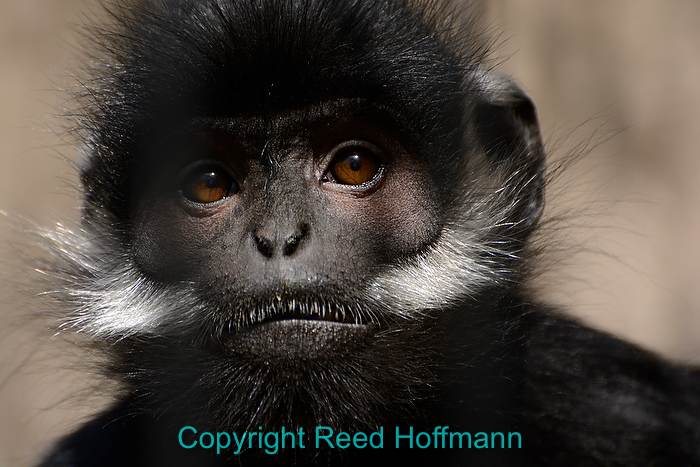Zoos are great places, particularly for photographers. Anytime I’m visiting a city and have time, I try to visit the zoo. Earlier this week, I dropped by ours here in Kansas City, to shoot some examples I need for upcoming workshops. It can be a challenge if crowded, but I’ll talk about that in a bit.
Before I left home, I printed out my shot list. Everyone should keep one of these, of photos they’d like to make. Mine is on my smartphone, and I add to it as I think of ideas or see other photos I like. While I’d have that list with me, I was also hoping to find other good pictures.
People sometimes ask me, “how do you find pictures so easily?” Mostly that has to do with experience and knowing how to work a scene. But I always try to start with some ideas in mind (like my shot list). As important as it is to begin with those ideas, it’s just as important to be open to new things, the unexpected.
When I first walk into an area, I look at it with my “wide-angle” eyes. That’s natural for us because our field of vision is pretty wide. I ask myself, “Can I make an interesting wide shot here?” Often times the answer is “no.” The problem with wide shots is they can be too “busy.” Too many things going on, there’s too much to look at, which makes it hard for the viewer to see what you found interesting. In addition to being busy, wide shots can be a challenge for light. You can have large areas that are either too bright or too dark, and that can also ruin the photo. So if wide’s not working, I switch to my “telephoto eyes.” It’s often easier to find pictures that way.
By “telephoto,” I mean I start looking at smaller areas of the scene, perhaps even details or close-ups. The advantages to this are easy to understand once you understand the problems of “busy” scenes. The less there is, the less likely your viewer will be distracted by other stuff. By zooming in, or getting closer and filling the frame, you’re limiting what your viewer can see. That makes it easier for them to quickly understand what you found interesting. (You’ll find a bunch of photos using this technique at the bottom of this page)
Arriving at the zoo, I found lots of buses and kids. Apparently a bunch of schools had picked this day for an end of school outing. As an optimistic, glass half-full kind of person, I tried to look on the positive side – If I wanted people in a picture, especially kids, that wouldn’t be a problem.
Kansas City recently opened a new polar bear exhibit, beautifully done with large glass windows where you can watch the bears swimming. That was the first place I wanted to visit, and as I walked up, one of the bears was doing laps and surfacing right in front of a window. Unfortunately, that window was packed with kids and had lots of reflection problems. It was also in the shade, so exposure could be a problem. That meant I got to practice something that becomes second-nature to photographers – problem solving.
I like to break photography down into two parts – the technical and the creative. My approach is to first solve the technical, then focus on being creative. The technical problem is usually with exposure and/or white balance. In this case, the light was daylight, so white balance wasn’t an issue. But because of the location, there wasn’t a lot of light, and that was a problem.
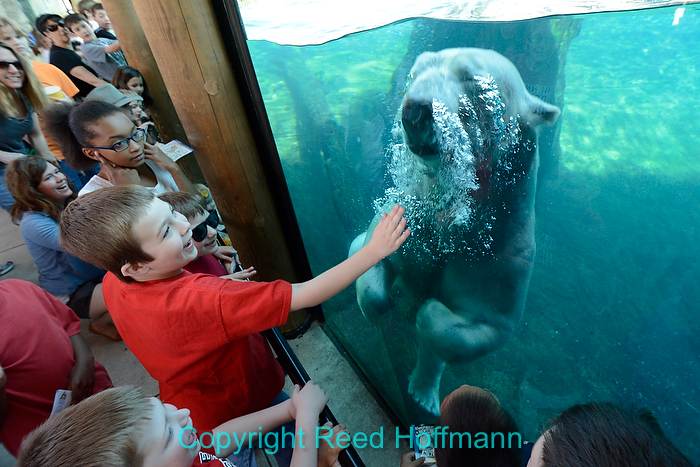
Once I had the exposure, then it was just a matter of finding a good angle. Nikon D5200 set to white balance of SUNNY and ISO of 1000, shutter speed of 1/200 at f/4.5, 10-24mm lens. Photo copyright Reed Hoffmann.
Many pictures are ruined by being blurry. Blur is simply action that hasn’t been stopped by a fast enough shutter speed. Since there wasn’t a lot of light where this action (polar bear swimming) was taking place, I risked blur if I didn’t pay attention to shutter speed. Noticing that it was around 1/100 second, I had a choice of either opening my aperture (f/stop) or raising my ISO, or both. I was at f/5.6, so I opened that to around f/4.5, and raised my ISO to 1000. That combination got me up to 1/200 second. Not as fast as I’d like, but fast enough to make the picture.
Balance in life is important, and it’s important in photography too. You often have to balance the exposure you’d like to have against any drawbacks. In this case, I’d like to be at 1/500 second, but that would mean going to a higher ISO, where noise and loss of color saturation could be an issue. Or open the lens wider, and lose some depth of field. So the “balance” here was a lower shutter speed than I’d like, to get the quality I wanted. This is why one of my big buzzwords in photography is “control.” Control means understanding exposure, and how to use it and the other choices, through menus and buttons, that your camera gives you. If you can’t control your camera, you’re less likely to get the pictures you want.
Once the technical was solved, it was time to get creative. I needed to find a position that minimized reflections and also let me see not just the bear, but the crowd’s reactions to it. That was solved by wedging myself into the corner, at the edge of the window, and using a wide-angle lens. Once I had those two problems taken care of (technical and creative), I could concentrate on trying to make a good picture.
For the next four hours I wandered around the zoo, looking for photos. First to find something I thought worth shooting, then figuring out the best way to do that. And that “best way” involved finding the right exposure and the best framing. Tackling the technical, and the creative. Photography’s a true left/right brain exercise.
It’s May, winter is over, and it’s time to get outdoors. Find a good subject (maybe the zoo?), set aside some time, and head out. It’s a great way to exercise not just your mind, but your body too.
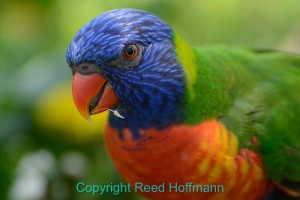
In one of the birdhouses, the wire mesh walls made for terrible backgrounds. But when one landed on a small grassy area to eat dandelions, I had my chance for a photo. Nikon D5200 set to white balance of SUNNY and ISO of 400, shutter speed of 1/200 at f/5.6, with exposure compensation at -0.3, lens at 300mm. Photo Copyright Reed Hoffmann.
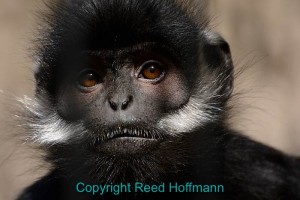
This little guy was behing bars, making it hard to get a clean shot of him. However, when he moved back from the bars, shallow depth of field at 300mm made them nearly disappear. You can barely see the two vertical shapes of the bars in front of his face. NIkon D5200 set to white balance of SUNNY and ISO of 200, shutter speed of 1/320 at f/5.6, 70-300mm f/4.5-5.6 lens. Photo Copyright Reed Hoffmann.
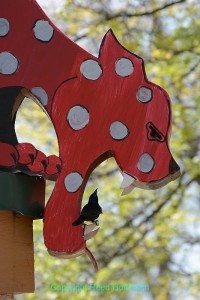
Walking by this concession stand, I saw a bird fly into the mouth of the Leopard. Then it was just a matter of waiting for it to happen again. Using a long telephoto lens kept the background defocused to keep the viewer’s attention on the bird in the mouth. Nikon D5200 set to white balance of SUNNY and ISO of 400, shutter speed of 1/800 at f/6.3, with exposure compensation at -0.3, 70-300mm lens at 240mm. Photo Copyright Reed Hoffmann.
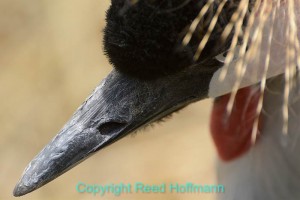
On a boardwalk looking down on these birds, I shot tight, a lot of frames, to get this composition of feathers, eye and beak. Nikon D5200 set to white balance of SUNNY and ISO of 400, shutter speed of 1/320 at f/8, with exposure compensation at 0.0, 70-300mm lens. Photo Copyright Reed Hoffmann.
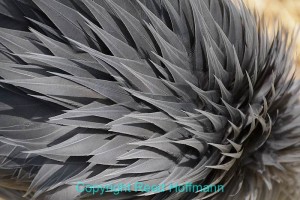
Same bird, I noticed the great pattern of its feathers in that light. Nikon D5200 set to white balance of SUNNY and ISO of 400, shutter speed of 1/800 at f/4.8, with exposure compensation at 0.0, 70-300mm. Photo Copyright Reed Hoffmann.
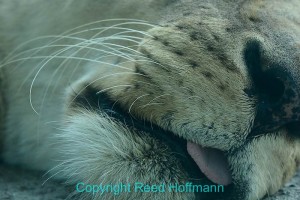
This time the glass let me go lens-to-mouth with a lion, something I normally wouldn’t want to do! Nikon D5200 set to white balance of SUNNY and ISO of 400, shutter speed of 1/80 at f/5.6, with exposure compensation at -0.3, 85mm f/1.8 lens. Photo Copyright Reed Hoffmann.
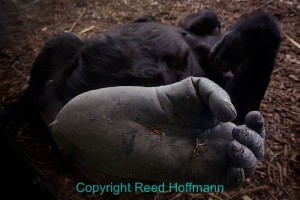
I normally hate shooting through glass, but it sometimes gives you interesting vantage points. In this case a close-up of a sleeping gorilla’s foot. Nikon D5200 set to white balance of SUNNY and ISO of 400, shutter speed of 1/60 at f/6.3, with exposure compensation at -1.0, 10-24mm lens. Photo Copyright Reed Hoffmann.

